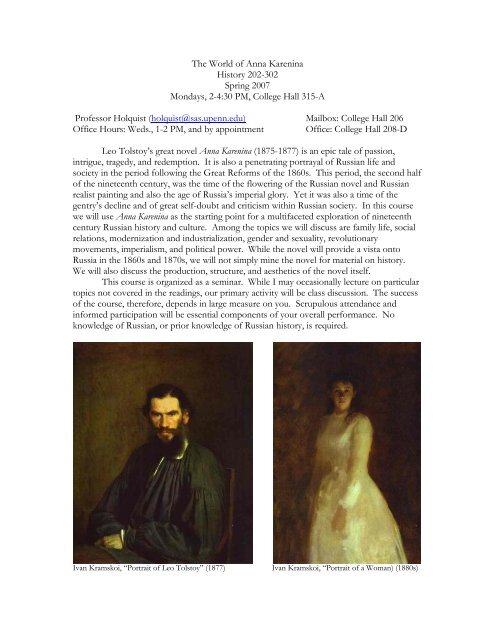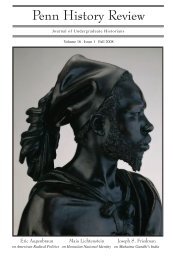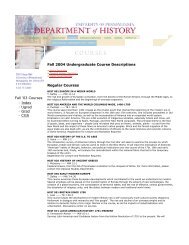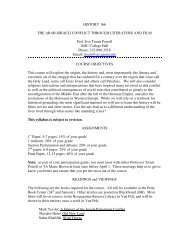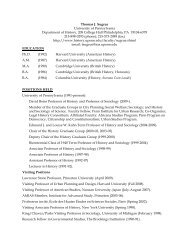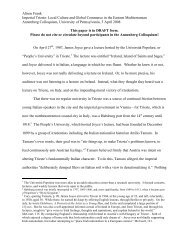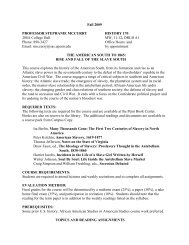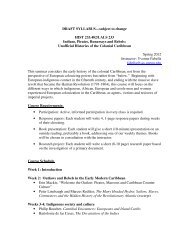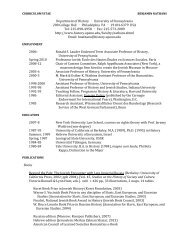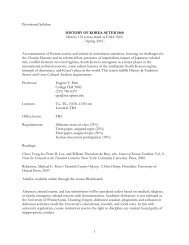The World of Anna Karenina
The World of Anna Karenina
The World of Anna Karenina
- No tags were found...
You also want an ePaper? Increase the reach of your titles
YUMPU automatically turns print PDFs into web optimized ePapers that Google loves.
<strong>The</strong> <strong>World</strong> <strong>of</strong> <strong>Anna</strong> <strong>Karenina</strong>History 202-302Spring 2007Mondays, 2-4:30 PM, College Hall 315-APr<strong>of</strong>essor Holquist (holquist@sas.upenn.edu) Mailbox: College Hall 206Office Hours: Weds., 1-2 PM, and by appointment Office: College Hall 208-DLeo Tolstoy’s great novel <strong>Anna</strong> <strong>Karenina</strong> (1875-1877) is an epic tale <strong>of</strong> passion,intrigue, tragedy, and redemption. It is also a penetrating portrayal <strong>of</strong> Russian life andsociety in the period following the Great Reforms <strong>of</strong> the 1860s. This period, the second half<strong>of</strong> the nineteenth century, was the time <strong>of</strong> the flowering <strong>of</strong> the Russian novel and Russianrealist painting and also the age <strong>of</strong> Russia’s imperial glory. Yet it was also a time <strong>of</strong> thegentry’s decline and <strong>of</strong> great self-doubt and criticism within Russian society. In this coursewe will use <strong>Anna</strong> <strong>Karenina</strong> as the starting point for a multifaceted exploration <strong>of</strong> nineteenthcentury Russian history and culture. Among the topics we will discuss are family life, socialrelations, modernization and industrialization, gender and sexuality, revolutionarymovements, imperialism, and political power. While the novel will provide a vista ontoRussia in the 1860s and 1870s, we will not simply mine the novel for material on history.We will also discuss the production, structure, and aesthetics <strong>of</strong> the novel itself.This course is organized as a seminar. While I may occasionally lecture on particulartopics not covered in the readings, our primary activity will be class discussion. <strong>The</strong> success<strong>of</strong> the course, therefore, depends in large measure on you. Scrupulous attendance andinformed participation will be essential components <strong>of</strong> your overall performance. Noknowledge <strong>of</strong> Russian, or prior knowledge <strong>of</strong> Russian history, is required.Ivan Kramskoi, “Portrait <strong>of</strong> Leo Tolstoy” (1877)Ivan Kramskoi, “Portrait <strong>of</strong> a Woman) (1880s)
Reading: ca. 200 pp. per week (usually less), including the novel and related materials. Allassigned readings must be completed before the class for which they are assigned, and youshould come to class prepared to ask questions and contribute insights.At each meeting we will discuss the novel as a work in its own right. As an exerciseto focus your reading, you will be expected to select one detail or exchange in each chapter andbe prepared to discuss it. That detail may be related to the novel’s aesthetics or structure(e.g., a telling or revealing character detail), or have to do with the novel’s historical times.Assignments and Grading:Participation: 20%Document analysis: 20% (Week 8)Bibliographic essay: 20% (Week 12)Final Paper: 40% (April 30)NOTE: Students in this course are expected to abide by the University <strong>of</strong> Pennsylvania’s Code <strong>of</strong>Academic Integrity. You may find the code at: http://www.vpul.upenn.edu/osl/acadint.htmlParticipation: A seminar is a collective experience, predicated on informed participation by, and discussionamong, its participants. Participation will constitute a significant portion <strong>of</strong> your grade for the class (20%).Remember that posing good questions is <strong>of</strong>ten more important than providing rote answers.For each session, one student will be responsible for providing an overview <strong>of</strong> thesections <strong>of</strong> the novel due for that week. This overview should not be a summary <strong>of</strong> thenovel’s content, but should raise questions about the novel’s development and its historicalsetting.In order to provide timely feedback on your seminar participation, we will scheduleindividual meetings in mid-semester to discuss your individual performance in seminar. Thismeeting will be purely diagnostic; it will not result in a grade.Assignments: Written work must be turned in on the designated due dates. I will accept latework only with prior approval in documented emergencies. In other words, if you have aproblem, you must let me know before the assignment is due. Standards <strong>of</strong> academicintegrity will be strictly enforced.You will be responsible for producing a 20-25 page research paper on a topic relatedto the novel. This topic may either address aspects <strong>of</strong> the novel’s composition andreception, or a historical issue portrayed in the novel. Midway through the course youshould develop some sense <strong>of</strong> a topic on which you might wish to write and begininvestigating that theme. In addition to mastering the source material, you will be expectedto identify primary source material (in English) for use in your analysis. I will provide abibliography with a list <strong>of</strong> works on particular themes and a list <strong>of</strong> memoirs available inEnglish.In order to develop your skills <strong>of</strong> document analysis, and to acquaint you withprimary source materials available in English, you will have a 6-8 page analysis <strong>of</strong> onedocument on Week 8. You may select a memoir or a document available in a documentarycollection or diplomatic reportage (especially that <strong>of</strong> the British Foreign Office).You will submit an 8-page bibliographic overview on your topic in week 12. Thatoverview should frame the theme you will write on, identify and analyze the relevantsecondary works treating that topic, and identify primary source materials you might employin your paper.
On week 14, the final class, you will give short oral presentations <strong>of</strong> your proposedtopic, allowing other students to comment on and contribute to your proposal.Your 20-25-page paper will be due on MONDAY APRIL 30.Readings: We will be using the following edition <strong>of</strong> the novel: Leo Tolstoy, <strong>Anna</strong> <strong>Karenina</strong>:<strong>The</strong> Norton Critical Edition, trans. Aylmer Maude, ed. and revised George Gibian, available forpurchase at the Penn Book Center (34 th and Sansom Streets).You are also required to purchase a coursepack. <strong>The</strong> coursepack is available at Wharton Reprographics,Suite 400, Ground Floor <strong>of</strong> the Wharton School, Locust Walk.Please bring both the coursepack and the novel to our seminar meetings.Walter Moss, Alexander II and His Times is found on-line at:http://www.emich.edu/public/history/moss/index.htm* = in coursepackView paintings, listed under the artist’s last name, at Olga’s Gallery (abcgallery.com)Week 1 (Jan. 8): IntroductionWeek 2: NO CLASS (Martin Luther King, Jr. Day)Week 3 (Jan. 22) “he occupied a distinguished and well-paid post” (pt. 1, ch. 5)• <strong>Anna</strong> <strong>Karenina</strong>, part 1, chapters 1-23 (pp. 1-76)Walter Moss, Alexander II and His Times, “Who’s Who” and Part I, sections 1-7* Gregory Freeze, “Reform and Counterreform, 1855-1890” in Russia: A History, ed.Gregory Freeze (New York: Oxford University Press, 1997), pp. 170-199* Sir Donald Mackenzie Wallace, “<strong>The</strong> Imperial Administration and Officials” inRussia on the Eve <strong>of</strong> War and Revolution (Princeton: Princeton University Press, 1984), chapter 1(pp. 3-26)At Olga’s Gallery, read biography <strong>of</strong> Pavel Fedotov (1815-1852) and view: “DifficultBride” (1847), “Untimely Guest (Aristorcrat’s Breakfast)” (1847-49), “Portrait <strong>of</strong> SecondCaptain Vannovsky” (1849), “Portrait <strong>of</strong> N. P. Zhdanovich at the Harpsichord” (1849-50);and, “<strong>The</strong> Major’s Marriage Proposal” (1851).Week 4 (Jan. 29): “the customary, careless Petersburg life” (pt. 1, ch. 34)• <strong>Anna</strong> <strong>Karenina</strong>, part 1, chapters 24-34; part 2, chapters 1-11 (pp. 77-136)* Sidney Monas, “St. Petersburg and Moscow as Cultural Symbols” in Art and Culturein Nineteenth Century Russia, ed. <strong>The</strong><strong>of</strong>anis George Stavrou (Bloomington: Indiana UniversityPress, 1983), 26-39.* Ge<strong>of</strong>frey Hosking, “Literature as ‘Nation-Builder’” in Russia: People and Empire(Cambridge: Harvard University Press, 1997), pp. 286-311. [OVER]
* Gary Hamburg, “<strong>The</strong> Nobility as a Social Formation,” chapter 1 <strong>of</strong> Politics <strong>of</strong> theRussian Nobility, 1880-1905 (New Brunswick, NJ: Rutgers University Press, 1984), pp. 9-19View: Vasilii Pukirev, “<strong>The</strong> Unequal Marriage” (1862) [view it athttp://www.russianartgallery.org/famous/pukirev.htm]; Ivan Kramskoi, “UnknownWoman” (1882) and Valentin Serov, “Portrait <strong>of</strong> Count Felix Sumarokov-Elstone, laterPrince Yusupov” (1903); and Ivan Kramskoi, “Leo Tolstoy” (1873) and Il’ia Repin, “Portrait<strong>of</strong> Leo Tolstoy” (1887)Week 5 (Feb. 5): “it vexes and hurts me to see on all sides the impoverishment <strong>of</strong> thenoblesse” (pt. 2, ch. 17); “he was fond <strong>of</strong> his regiment . . .” (pt. 2, ch. 18)• <strong>Anna</strong> <strong>Karenina</strong>, part 2, chapters 12-29 (137-194)Walter Moss, Alexander II and His Times, Part I, sections 8-14* Seymour Becker, Nobility and Privilege in Late Imperial Russia (Dekalb, Ill.: NorthernIllinois University Press, 1985), pp. 7-14, 28-31, 36-43* William Fuller, Civil Military Conflict in Imperial Russia, 1881-1914 (Princeton:Princeton University Press, 1985), pp. 15-32View: Vladimir Makovskii (Makovsky), “Declaration <strong>of</strong> Love” (1889) andKonstantin Savitskii (Savitsky), “Repairing the Railroad” (1874) [search for both via “GoogleImages”]; Valentin Serov, “Portrait <strong>of</strong> Grand Duke Pavel Aleksandrovich” (1897) and“Portrait <strong>of</strong> Prince Felix Yusupov, Count Sumarokov-Elstone” (1903) [both at Olga’sGallery].Week 6 (Feb. 12): “he will take my son from me, and probably their stupid laws will permitit” (pt. 3, ch. 16); “the countryside . . . where one rejoiced, suffered, and labored” (pt. 3, ch.1)• <strong>Anna</strong> <strong>Karenina</strong>, part 2, chapters 30-35; part 3, chapters 1-18 (195-275)* Laura Engelstein, <strong>The</strong> Keys to Happiness: Sex and the Search for Modernity in Fin-de-SiècleRussia (Ithaca: Cornell University Press, 1992), pp. 17-28, 51-55* William Wagner, “<strong>The</strong> Trojan Mare: Women’s Rights and Civil Rights in LateImperial Russia” in Civil Rights in Imperial Russia, ed. Olga Crisp and Linda Edmondson(Oxford: Clarendon Press, 1989)* Isaiah Berlin, “Russian Populism” in Russian Thinkers (New York: Penguin Books,1978), pp. 210-238* Leopold Haimson, <strong>The</strong> Russian Marxists and the Origins <strong>of</strong> Bolshevism (Boston: Beacon,1966), chapter 1 (pp. 3-27)View at Olga’s Gallery: skim the bucolic images <strong>of</strong> Fedor Vasiliyev (1850-1873) and IvanShishkin (1832-1898); skim also the portraits <strong>of</strong> peasants by Ivan Kramskoi and Ilya Repin. View esp. IlyaRepin, “Portrait <strong>of</strong> Leo Tolstoy as a Ploughman” (1887).* * * INTERIM MEETING ON PARTICIPATION: (schedule your meetingsindividually with me) * * * *


